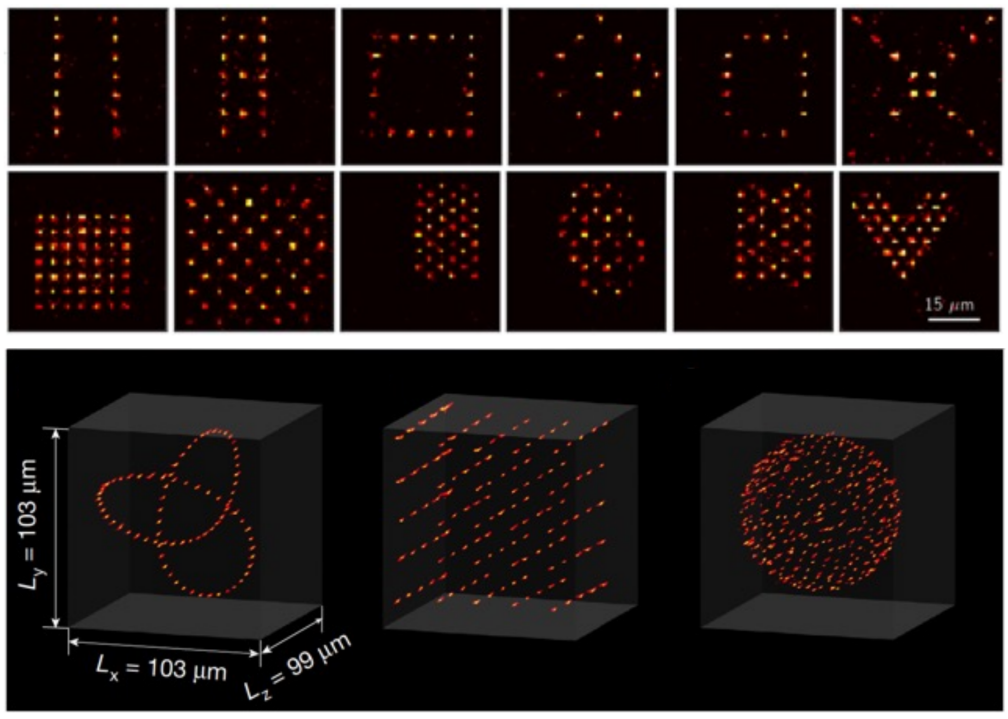In 2016, Immanuel Bloch from the Max-Planck-Institut für Quantenoptik in Germany, and his team, provided the first example that “highlights the power of quantum simulations” to answer a scientific question. They were able to observe a phase transition in a range of parameters inaccessible to state-of-the-art classical computers. Their experimental setup was based on controlling individual atoms with lasers.
Later, in June 2021, Antoine Browaeys, Thierry Lahaye from the Universite of Paris-Saclay, Institut d’Optique Graduate School in France, and collaborators simulated magnetism in matter at fundamental level using a programable neutral atoms quantum processor. They successfully used 196 qubits to recreate the Ising model. Their results were published in Nature.
At the moment, with this experiment, Browaeys and his team demonstrated the capacity of their quantum device—the same kind of device developed at PASQAL—to outperform supercomputers to solve scientific problems before the fault-tolerant era.
Since Bloch team’s work in 2016, researchers from many academic institutions and companies, including Browaeys’ team and PASQAL have shown that individual control of neutral atoms is the natural experimental setup to simulate different kinds of interactions at atomic level, surpassing classical computers capacity. These teams have repeatedly demonstrated (see, for instance, here, here, and here) that this platform is ready to address open questions in science.
So, how do neutral atoms quantum processors work and what are the reasons behind their remarkable progress?
Neutral atoms: the right quantum tool to address many-body physics
In neutral atom quantum devices, a sort of vapor of atoms–typically rubidium or strontium–is created inside a vacuum chamber. Then, scientists use highly-focused lasers, so called optical tweezers, to trap and manipulate those suspended atoms individually and create with them 1D, 2D, and 3D arbitrary shapes. In these architectures, the information is encoded by manipulating the atoms’ electronic states to create qubits, the quantum information units. Each qubit is represented by a two-level energy state in an atom, usually a ground state and a Rydberg state. In the Rydberg state, atoms are polarized, facilitating van der Waals’ interactions and entanglement. PASQAL current architecture uses rubidium atoms as qubits, an easy to mine alkali element that benefits from well-established laser technology, especially to bring its electrons to a variety of energy levels, including very high Rydberg states.

Being able to control atoms individually and to arrange them in arbitrary configurations is a remarkable feature of neutral atom quantum processors. This means that in these setups, neutral atoms can be prepared to simulate ensembles of interacting atoms, molecules, and any other object showing quantum properties. The study of these systems is called many-body physics.
For instance, in neutral atoms devices, the qubits can be arranged to represent atoms in a macromolecule of life or a lattice of atoms in a mineral, and the interactions between those atoms in a macromolecule or a lattice emulated through van der Waals’ interactions of the Rydberg atoms.
But what makes quantum calculations with neutral atoms reliable in regimes beyond what we can calculate classically comes from its ability to embrace the analog mode. Although the digital approach—the one used in superconductors architectures—has been shown to be universal in classical computers, the quantum analog mode is prone to fewer errors, which is crucial in achieving near-term quantum advantage while still working with noisy qubits.
Analog vs digital
A distinctive feature of neutral atoms is their capacity to run in both analog and digital modes. In digital quantum computing, the computer executes algorithms by implementing sequences of discrete operations, commonly known as quantum gates. In the analog case, the user has control over a few parameters and the quantum computer evolves towards an answer continuously. The analog mode can do in one computational step what the digital mode would require thousands of steps.
Moreover, while digital computing is universal, the risk of errors increases for each gate created. This is because individual gates are noisy and errors compound. Thus, even large (multi-qubit)digital quantum computers have very limited capabilities. In contrast, the analog mode is less susceptible to noise.
Immanuel Bloch, Mattias Troyer, and their team, last year, analyzed the propagation of errors for analogue and digital quantum simulators in problems of interest in material sciences. They identified the requirements for quantum simulations to be reliable in regimes beyond what can be calculated classically with existing methods.
For example, they calculated that a digital quantum computer would require hundreds of thousands of gates to reach the same error obtained for an analog simulation running an Ising model for 100 magnets. They concluded that “analogue simulators are the best means to accurately perform computations and confirm that existing experiments already passed the requirements for quantum advantage.
The future of quantum devices
Through the versatility of neutral atoms platforms, different groups of scientists have demonstrated that quantum computing is ready to address scientific questions, not only to simulate many-body physics, but to discover new phenomena in material sciences, for example in observing new features in phase transition.
One advantage of superconductors vs neutral atoms is that digital gates offer more flexibility to include different kinds of interactions in the model, while with individually controlled atoms one can only use one kind of van der Waals interactions.
Even with this limitation, analog neutral atom devices can be used advantageously outside the scope of physics. For example, PASQAL researchers successfully implemented algorithms based on graphs, allowing them to address problems in finance and healthcare.
The progress achieved by Immanuel Bloch and his team 7 years ago, Antoine Browaeys and his team 2 years ago (with 196qubits), PASQAL, and a few months ago by IBM (with 127 qubits), show that the race to showcase industry-relevant quantum advantage with near-term quantum computers is entering its final stages. Several approaches are competing to reach this milestone first, being neutral atoms-based quantum computers, one of the most promising technologies to achieve early quantum advantage, as featured in this piece in Nature.
Advances in classical computational resources also constantly occur and those advances may lead to better simulations catching up with quantum experiments. Then again, quantum devices can be further developed and again go beyond what classical computers can do. And this back and forth is good for the healthy development of quantum technologies.
References
- Scholl, P., Schuler, M., Williams, H. J., Eberharter, A. A.,Barredo, D., Schymik, K., Lienhard, V., Henry, L., Lang, T., Lahaye, T.,Läuchli, A. M., & Browaeys, A. (2021). Quantum simulation of 2Dantiferromagnets with hundreds of Rydberg atoms. Nature, 595(7866), 233–238. https://doi.org/10.1038/s41586-021-03585-1
- Choi, J., Hild, S., Zeiher, J., Schauss, P., Rubio-Abadal, A.,Yefsah, T., Khemani, V., Huse, D. A., Bloch, I., & Gross, C. E. (2016).Exploring the many-body localization transition in two dimensions. Science,352(6293), 1547–1552. https://doi.org/10.1126/science.aaf8834
- Browaeys, A., & Lahaye, T. (2020).Many-body physics with individually controlled Rydberg atoms. Nature Physics,16(2), 132–142. https://doi.org/10.1038/s41567-019-0733-z
- Flannigan, S., Pearson, N., Low, G. H.,Buyskikh, A., Bloch, I., Zoller, P., Troyer, M., & Daley, A. J. (2022).Propagation of errors and quantitative quantum simulation with quantumadvantage. Quantum Science and Technology, 7(4), 045025. https://doi.org/10.1088/2058-9565/ac88f5
Would you like to learn more about these techniques on a neutral atom quantum computer? Get familiar with quantum computing, our platform, and algorithms with Quantum Discovery.


